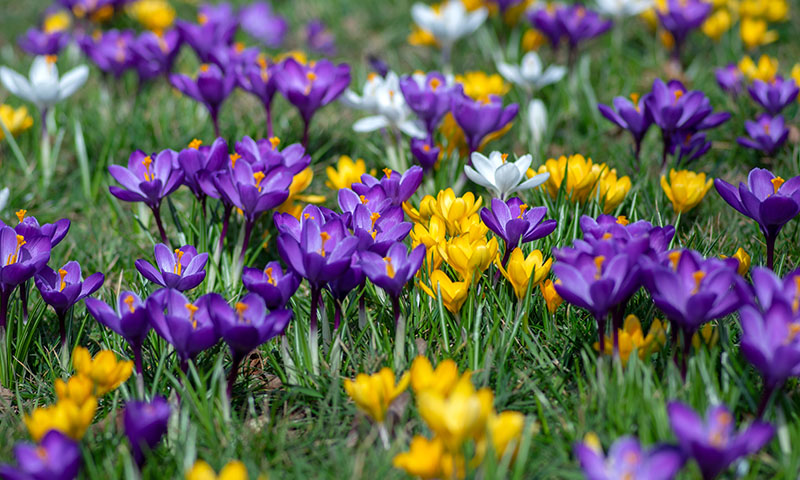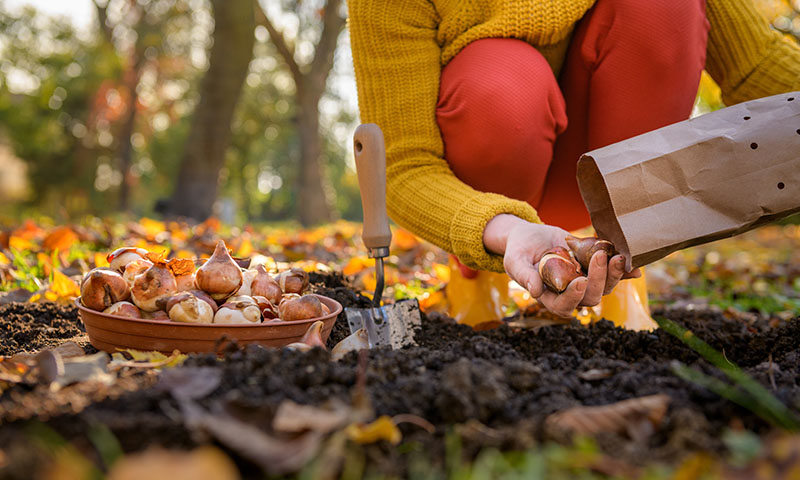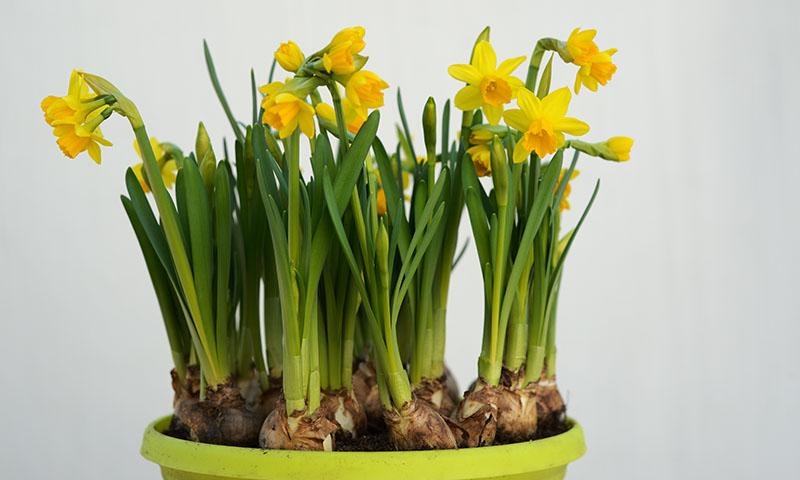How to Plant Early Spring Flower Bulbs in Fall
Just when it seems winter will never end, spring showers show up and wash away winter's grime. We've all heard the saying that those showers bring flowers, but that's not all they bring. They also trigger a serious case of tulip envy when your neighbor's landscape is filled with spring-blooming bulbs.
There's no denying that Mother Nature outdid herself with tulips, daffodils and other spring-bloomers. Whether you're into pale pastels, vibrant primary colors or goth-garden black, spring bulbs put on a spectacular show.
But here's the rub if you're new to gardening or just discovered the joys of bulbs: You have to plan ahead and plant those bulbs in fall to get the spring show you're yearning for. We're here to tell you how.
- How to Plan a Spring Bulb Bonanza
- How to Plant Spring-Blooming Bulbs
- How to Cheat if You Just Can't Wait
How to Plan a Spring Bulb Bonanza

Crocus bloom early in spring (and look great naturalized in lawns).
Once tulips and daffodils have your attention, they'll keep it — especially once you find out that they come in early season, midseason and late-season types. By planting a variety of these spring bloomers, even just tulips and daffodils, you can wow your neighbors with an extended display of traffic-stopping blooms.
Choose right and you can keep the show rolling from spring's earliest days all the way to summer, until your garden's hot summer blooms take off.
Just to build on that excitement — because we know you're feeling it — there's a bevy of other spring-blooming bulbs you can add to kick your bulb bonanza up a few more notches. Here's just a sampling to get your plans flowing:
Snowdrops are one of spring's earliest bloomers. These little beauties have a habit of breaking through remnant snow with tiny white flowers. Hence the name.
Crocus are another early spring bloomer that's perfect for creating layers of underlying color around the feet of your tulips and daffodils.
Hyacinth blooms hit your garden midspring, from white to deepest purple, with the sweetest fragrances of the season.
Alliums, aka ornamental onions arrive in late spring. From minimalist to maximalist, their straight, sturdy stems and rounded blooms carry your garden through spring and beyond.
Mix it up with whatever suits your garden style. The only rules are yours.
How to Plant Spring-Blooming Bulbs

Repeat after us: Fall planting party.
Once you've decided on petal palettes and bloom times, you can really let loose. Plant spring-blooming bulbs en masse or in singles. Create designs or interesting shapes — or go for a wildflower look and scatter heirloom daffodils around your landscape.
Whatever planting scheme you land on, make sure your planting sites have plenty of sun and good drainage. (Bulbs and wet, soggy soil don't mix. Root rot is not your friend.)
Plant your bulbs about 6 weeks before the soil in your garden normally freezes. This gives your bulbs plenty of time to settle in and generate roots. (It's also a perfect excuse for a fall planting party.) In cooler northern climates, ideal planting time runs from September through October. In warmer areas, late October and November may be best. If you're clueless when it comes to freeze dates, do a quick zip code search and you find out. Then count 6 weeks back.
Planting depth depends on the type of bulb you plant, but a general rule is to plant them 2 to 3 times as deep as the length of the bulb. And — this is important — always plant the pointy end up. That's the end your flowers will come from. Because you're planting based on bulb size, don't hesitate to put bulbs close together and layer smaller bulbs on top of larger ones. That's how those over-the-top spring bulbs gardens come to life.
To prepare your soil, loosen it with a hand trowel or small spade. (If you have heavy clay soil in your region, Lilly Miller Garden Gypsum can help improve compacted soil over time.) Mix in a plant food designed specifically to give bulbs the nutrients they need. Bulbs love phosphorus, so look for foods with a higher middle number in the N-P-K- on the label, like Pennington Rejuvenate Plant Food Rose & Flower 4-6-3. When you're through, water the area well. Then start daydreaming about spring.
One final task happens when your bulbs are through blooming. If you want to leave them in place to bloom again next year, leave the foliage intact until it turns yellow and dies back. This helps the bulb store up the energy it needs for another year. Of course, you can always start from scratch and change things up every fall planting season. That's the nice thing about having your own slice of earth where nobody calls the shots but you!
How to Cheat if You Just Can't Wait

Skip the wait and buy spring bulbs already in bloom.
If spring hits and your bulb-less garden leaves you feeling empty-handed and impatient, we get it. We've been there, too — and here's what we do. Most garden centers and nurseries offer spring bulb gardens as soon as winter starts waning.
These mini bulb plantings usually come in plastic bulb pans, about 6 inches deep. Some have just a few bulbs, while others can be up to 12 inches across with a wild mixture of all kinds of spring-blooming bulbs. If you want instant color, go for open flowers. If you want to stretch out your bloom time, choose tight flower buds and blooms.
Don't take the bulbs out of the pans — keep them right where they are and don't disturb them a bit. Take your trowel and dig 6 inches deep (or the height of your pan) in the shape of your bulb garden — either in your garden or in containers that need a spring lift.
Then sink the pan down into the soil, cover its edges with a light layer of mulch, and voilà! Instant blooms to impress the neighbors and instant gratification for you. Treat your bulbs to a snack while you water them in with our liquid Pennington All-Purpose Plant Food 2-3-2 or our Pennington Water Soluble All-Purpose Plant Food 20-10-20.
Here at Pennington, we're on board with helping you do garden your way. Whether that's springtime tulips, clover-filled pollinator lawns and wildflower meadows, or homegrown food. Have a question? We have answers, so send it our way. Let us help you nurture your roots.
Always read product labels thoroughly and follow instructions.





